By Eilene Lyon
First, the name. Legend has it that an unauthorized expedition of Spaniards led by Antonio Gutierrez de Humaña and Francisco Leyva de Bonilla, came to what is now southern Colorado in 1594 (a much-disputed legend at that). On their way home, Humaña murdered Bonilla in order to make off with all the burros loaded with gold.
Humaña didn’t get very far before he and his remaining men (except perhaps one) were murdered by Indians: maybe Comanche, maybe Ute, maybe Jicarilla Apache. There were no priests to consecrate the bodies where they were buried by a stream. Therefore the river obtained the name “Rio de las animas perdidas en Purgatorio.” River of souls lost in Purgatory.
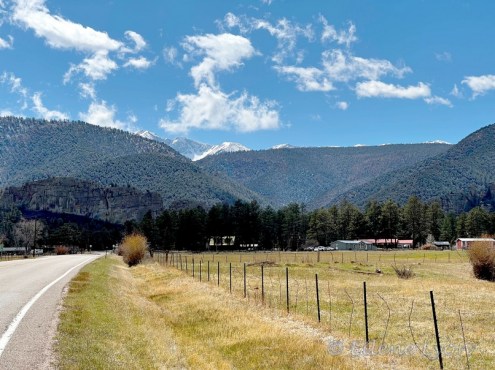
Often called the Las Animas River, French trappers called it Le Purgatoire. If you know your high school French pronunciation, you can understand why the Anglos who settled along this river (which the Santa Fe Trail followed after 1821), called it the Picketwire River.
The Purgatoire flows from the Sangre de Christo Mountains west of Trinidad, flowing east then northeast to meet the Arkansas River. Before the confluence, it flows through a land of canyons. A group of pioneers from Trinidad moved to one of the lower canyons, calling it Nine Mile Bottom.
These were hardy settlers, self-sufficient. They built a dam to irrigate nine miles of the canyon bottom. Because the nearest Catholic Church was in Trinidad, Damacio Lopez offered a piece of land to the Church if a priest would ride out to provide services. This became known as the Dolores Mission.
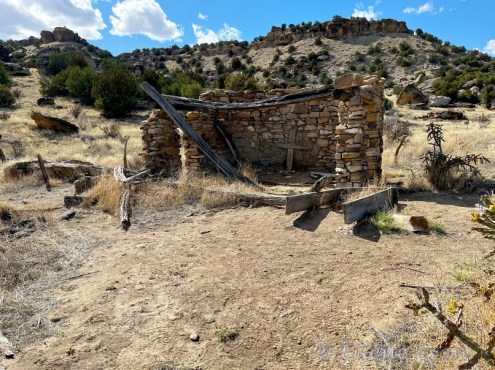
This area is now part of the Comanche National Grassland. For some unknown reason, the federal government went a step further, splitting the name: Picket Wire Canyonlands.
We drove south from La Junta on Hwy 109 to County Rd. 802, heading southwest, then south on County Rd. 25. These gravel roads (about 20 miles) were smooth riding. Then we turned east on a Forest Service road driving three miles of godawful washboard to arrive at the Withers Canyon Trailhead. There are four campsites and a pit toilet. Fortunately, a couple sites were still available.
It was already about 3:00 in the afternoon and we had an 11.2-mile round trip to make on our mountain bikes. We talked to a local couple before reaching the trailhead, so we knew there was a new roadcut to take us down into the canyon, instead of riding down the old hiking trail. I wish I had taken a picture. Steep and rough, but rideable going down—coming back up, not. We pushed the bikes the entire way up 300 feet of elevation back to camp.

It was a gorgeous afternoon and most of the trail was gentle on our legs. At about four miles, we came to the ruins of the mission so I could photograph the tiny cemetery with four remaining headstones.
About a half mile later, we came to this dinosaur scapula. This is actually a replica.
A mile further on, we came to the feature we’d come to see: the largest collection of dinosaur tracks in the world. (If we’d had the time and energy, we might have gone a couple miles further to see the remains of the Rourke Ranch.)
This desert canyon was a large lake 150 million years ago. Large herbivorous dinosaurs waded in the shallows and the muddy lake shores, leaving tracks that eventually solidified into bedrock under today’s shallow river. These prints are reminiscent of elephant tracks. Some carnivorous dinosaur tracks are also found in the stone, in a three-toed pattern.
It is possible to drive in to the Rourke Ranch and Dinosaur Tracks by continuing on County Rd. 25. The bike ride was a good way to access the canyon, and a pleasant trip. After viewing the tracks, we headed back to camp.
We enjoyed a peaceful, relaxing evening, with nearby views into the surrounding canyons where the turkey vultures soared and gentle river flowed.
Feature image: The Purgatoire River as it flows through Picketwire Canyon
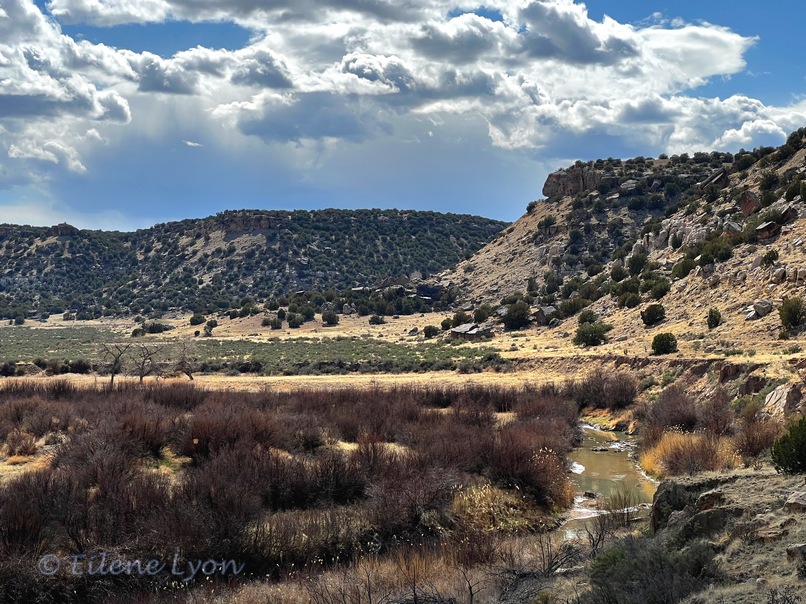
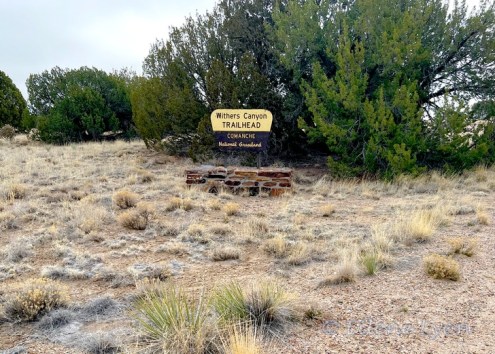
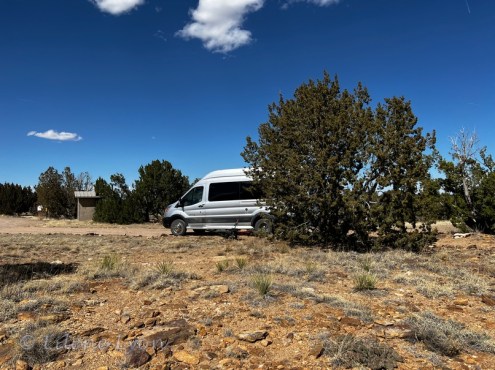

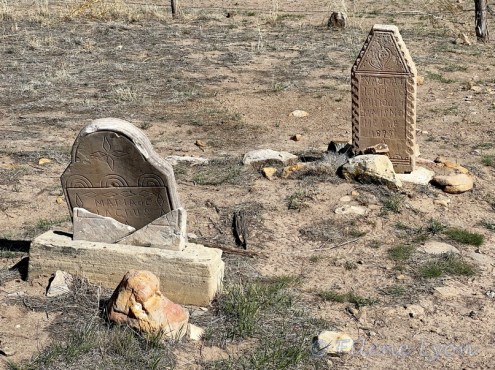
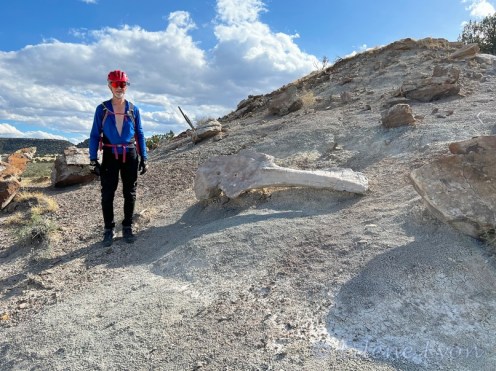







So cool!!
LikeLiked by 1 person
Not the typical tourist stop, for sure!
LikeLiked by 1 person
What a wonderful share, Eilene! Needless to say, Picketwire vs Purgatoire gives me a good chuckle. I love to hear how names come to be so the whole history of it was fascinating to me.
What a cool place to camp!
LikeLiked by 1 person
Glad you liked the story. I know you can appreciate the French to English conversion.🙂 I love the legends, even if they aren’t true.
LikeLiked by 1 person
Indeed. And yes, legends, true or not are more than welcome!
There are English words that get “bastardized” in French, as well. An outhouse, also called the back house, became the bécosse in French (still used today, even if the toilet is inside!)
LikeLiked by 1 person
That’s a good one. I notice that with other English words that don’t translate to other languages. They just add the word with modified pronunciation (and possibly spelling). Frequently a result of technology or the internet.
LikeLiked by 1 person
There are quite a few like that. You know those rubbers men put on their shoes in winter? In Quebec, they call them “shoe clacks” or rather shoe claques! How the hell did that come to be?
But yes, And we borrow from other languages as well. It’s rather fascinating 🙂
LikeLike
How I’ve enjoyed the history and stories!
LikeLiked by 1 person
Thank you, Joy!
LikeLiked by 1 person
What a fabulous trip. Such an interesting place to visit prehistoric and recent history all in one stop!
LikeLiked by 1 person
It does have many different layers of time to explore. I could hang out there a while, but we had to move on.
LikeLiked by 1 person
Happy travels!
LikeLiked by 1 person
Thanks!
LikeLiked by 1 person
Beautiful photographs and a history lesson all in one. This was a very interesting read, but not as near interesting as being there I bet. Thanks for taking me on this trip.
LikeLiked by 1 person
Thanks! It was a great place to visit. Wish I had spent more time there.
LikeLike
I love learning about this part of Colorado Eilene- I need to start a future visits list called “Not the Rockies” and venture in other directions 😉
LikeLiked by 1 person
There really is a lot more here than mountains, Deb, for sure!
LikeLiked by 1 person
I’ve been down in that area a number of times and didn’t know about what you wrote here. Next time I’m down there, I’ll know just a little more.
LikeLiked by 1 person
What sort of interesting things have you encountered there?
LikeLike
Seems of Coal, Fossils, things like that.
LikeLiked by 1 person
How amazing to walk in dinosaur footprints!
LikeLiked by 2 people
Just like they were there only yesterday. HA.
LikeLiked by 2 people
Eilene, I’m very impressed with your cycling adventure. As I sit here trying to gather momentum to head into the cold yet sunny morning 😎
LikeLiked by 1 person
We’re still doing cold and sunny here, but we’re waxing warm, while you wax cold. Perhaps you’re ready for the hibernation season?
LikeLiked by 1 person
For me, it means more walks without looking like a beetroot with legs 😉 Plus, a certain amount of hibernation though for us that is nothing new.
LikeLiked by 1 person
Well, that’s a picture, but I doubt an accurate one! Enjoy the fall weather, Suzanne.
LikeLiked by 1 person
I enjoyed the history, the account of your adventure, and the photos in equal measure!
LikeLiked by 1 person
Thank you, Liz!
LikeLiked by 1 person
You’re welcome, Eilene!
LikeLiked by 1 person
Looks like a fun trip – LOVE the dino tracks! 🙂
LikeLiked by 1 person
It was my first time really exploring that part of the state. Definitely some worthwhile places to see and things to do.
LikeLiked by 1 person
I always enjoy the stories of your adventures. This sounds like a fun day!!
LikeLiked by 1 person
It was. I had planned it for later in the week, but the weather was turning. Had to get out there while it was nice.
LikeLiked by 1 person
Yes! Make hay while the sun shines!
LikeLiked by 1 person
😊
LikeLike
Purgatory? Picket? Who’s to say, right? Your bike ride took you to some interesting sights. The fake dinosaur bone made my day.
LikeLiked by 1 person
What kid (even ones in their 60s and 70s) doesn’t love a dinosaur bone?!
LikeLiked by 1 person
The history and the scenery read and look like something out of a movie. Narrated brilliantly by you, of course.
LikeLiked by 1 person
That’s my next career – documentary films a la David Attenborough.
LikeLiked by 1 person
Go get ’em!
LikeLiked by 1 person
😁
LikeLiked by 1 person
Wow, that first story sounds like something out of a gruesome old Western. And I love how Purgatoire became Picket Wire! But the best was seeing those photos of the dinosaur tracks. Amazing!
LikeLiked by 1 person
Yeah, that would make a movie, for sure.😆 The dino tracks are pretty cool!
LikeLiked by 1 person
I know you like vintage venues Eilene, but dinosaur bones, even fakes ones, was a fabulous find. Your bike and you had a workout for sure!
LikeLiked by 1 person
It was a good workout, indeed!
LikeLiked by 1 person
Fascinating piece Eilene, particularly the origin of the name. In Ireland, because the Gaelic language was banned under British rule, a lot of the place names are anglicised versions of Gaelic names. So, for example, ‘town’ in gaelic is “baile” (ballyeh) which anglicised becomes “Bally”…..BallyShannon. Ballymun, Ballybunion…etc.
LikeLiked by 1 person
It’s that way all over, sadly. Too much Anglicization. We appropriated a lot of Native American names in this country and changed them.
LikeLike
What an extraordinary world we live in. Your day sounds exhausting but very fulfilling.
LikeLiked by 1 person
We enjoy mountain biking quite a bit. It’s easier on my knees and back than hiking now. Picketwire Canyon really was unique.
LikeLiked by 1 person
Amazing photos – and those dinosaur prints. So cool!!!
LikeLiked by 1 person
I was glad I learned about this place and that we managed to get in there before the spring weather turned nasty. It is a very cool place, for sure!
LikeLike